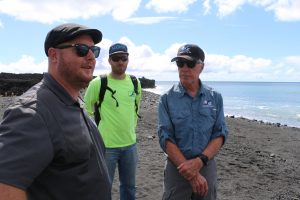06/10/19 – ENGINEERS RECOMMEND NEW BOAT RAMP FOR LOWER PUNA AFTER ERUPTION Pohoiki Clearing is Prohibitively Expensive
Posted on Jun 10, 2019 in Boating & Ocean Recreations, News Releases, sliderNews Release
| DAVID Y. IGE GOVERNOR |
SUZANNE D. CASE
CHAIRPERSON |
For Immediate News Release: June 10, 2019
 (Click on image to watch video)
(Click on image to watch video)
ENGINEERS RECOMMEND NEW BOAT RAMP FOR LOWER PUNA AFTER ERUPTION
Pohoiki Clearing is Prohibitively Expensive
(Honolulu) – While it’s technically possible to remove sand and create a channel to the Pohoiki Small Boat Ramp on Hawai‘i Island’s lower Puna coast, an engineering study commissioned by the DLNR Division of Boating and Ocean Recreation (DOBOR) finds that it would be very expensive and full of uncertainties associated with sand movement and costal processes continuing in and around Pohoiki Bay. The ramp was closed shortly after Kīlauea began erupting last May and eventually became land-locked by what is now a 200-foot-wide black sand and cobblestone beach.
Representatives from Sea Engineering Inc. visited Pohoiki on May 1, 2019 and then produced a 32-page-long report which states, “The recent volcanic activity and lava flow has resulted in the formation of hundreds of thousands of cubic yards of black sand and cobbles at the lava-ocean interface, which has been carried southward by coastal  currents and now completely fills Pohoiki Bay, rendering the existing Pohoiki boat ramp land-locked and useless.”
currents and now completely fills Pohoiki Bay, rendering the existing Pohoiki boat ramp land-locked and useless.”
Ed Underwood, DOBOR Administrator, said the engineering study also revealed, “Constructing a new ramp at an alternate site would be a more straightforward project, however the rocky sea cliff Puna coastline provides few ideal locations. Seismic and volcanic activity is also a concern virtually anywhere along this coast. The alternate site evaluated in this study, “Mālama Flats” (just south of McKenzie State Recreation Area), appears to offer reasonable conditions for design of an inland excavated ramp facility, however no quantitative site information is presently available. The ramp alternative as presented is basically a generic ramp design placed on the Mālama Flats topography. Estimated construction costs are considered representative for this type of ramp facility.”
The engineering study found that no matter where the state builds a ramp along the lower Puna Coast it will be challenging. Engineers studied an area extending approximately 10 miles south from Pohoiki Bay to Kalapana, where the coast road turns inland. The report found, “The shoreline is almost entirely rocky sea cliffs, with deep water close to shore and relatively high (+20 to +30 feet) nearshore ground elevations. There are no shallow water embayments or significant headlands to provide natural wave protection. The coast is directly exposed to the persistent prevailing trade wind generated seas. Tropical storms and hurricanes passing south of the island generate large waves that can batter the coast.”
In order to re-open the Pohoiki Boat Ramp a channel would have to be excavated through the new beach and maintained open by shore-perpendicular jetties. Given the continuing production of volcanic sand, and the dynamic and variable waves and currents along the coast, a jetty on both sides of the channel is considered necessary to insure the continued navigability of a channel through the beach. Sea Engineering estimates it would cost approximately $37.9 million to restore the Pohoiki ramp.
The estimated cost for a new facility at Mālama Flats is estimated at $14.5 million and would include:
- A 295-foot long, 100-foot wide, and 6-foot deep entrance channel excavated inland.
- A 0.6 acre launching and turning basin, 6 feet deep.
- 830 linear feet of rock wave absorber along the entrance channel and basin.
- A single lane concrete boat launch ramp, 18 feet wide and 128 feet long.
- A 24-foot wide, 60-foot long concrete ramp approach pad. • A 30-foot long, 5-foot wide concrete loading dock, complete with fenders and mooring hardware.
- A 100-foot long, 5-foot wide, ADA compliant loading dock approach walkway.
- Approximately 1,330 linear feet of lava rock (CRM) retaining wall, 2 to 4 feet high, to permit raising the ground elevation in the ramp vicinity.
- Material excavated from the channel and basin would be used as compacted fill to create a uniform +10-foot elevation backshore support area. This is necessary to prevent occasional flooding of the ramp facility by wave runup.
- A two-lane, 24-foot wide, asphalt access roadway approximately 680 feet long.
DOBOR will need to work with the Federal Emergency Management Agency (FEMA) to secure appropriate funding to build a new ramp and associated facilities and when and if that happens will have to obtain appropriate permits and hold public hearings or informational meetings with local boaters and the community.
# # #
Media contact:
Dan Dennison
Senior Communications Manager
Hawaii Dept. of Land and Natural Resources
[email protected]
(808) 587-0396